1/14/2008 by Friendsinrome Italy
 Celio is the XIXth rione of Rome. Its logo is the bust of an African, with an elephant headdress with golden tusks on a silver background, in memory of an African bust that was found in via Capo d'Africa.Celio is also one of the famous Seven Hills of Rome. Under reign of Tullus Hostilius, the entire population of Alba Longa was forcibly resettled on the Caelian Hill. According to a tradition recounted by Titus Livy, the hill received its name from Caelius Vibenna, either because he established a settlement there or because his friend Servius Tullius wished to honor him after his death.In Republican-era Rome the Caelian Hill was a fashionable residential district and the site of residences of the wealthy. Archeological work under the Baths of Caracalla have uncovered the remains of lavish villas complete with murals and mosaics.
Celio is the XIXth rione of Rome. Its logo is the bust of an African, with an elephant headdress with golden tusks on a silver background, in memory of an African bust that was found in via Capo d'Africa.Celio is also one of the famous Seven Hills of Rome. Under reign of Tullus Hostilius, the entire population of Alba Longa was forcibly resettled on the Caelian Hill. According to a tradition recounted by Titus Livy, the hill received its name from Caelius Vibenna, either because he established a settlement there or because his friend Servius Tullius wished to honor him after his death.In Republican-era Rome the Caelian Hill was a fashionable residential district and the site of residences of the wealthy. Archeological work under the Baths of Caracalla have uncovered the remains of lavish villas complete with murals and mosaics.
Map with Celio's attractions
Zoom in and click the map icons for more details on each attraction in Trastevere:
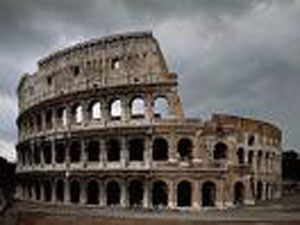 Originally capable of seating around 50,000 spectators, the Colosseum was used for gladiatorial contests and public spectacles. It remained in use for nearly 500 years with the last recorded games being held there as late as the 6th century. As well as the traditional gladiatorial games, many other public spectacles were held there, such as mock sea battles, animal hunts, executions, re-enactments of famous battles, and dramas based on Classical mythology. The building eventually ceased to be used for entertainment in the early medieval era. It was later reused for such varied purposes as housing, workshops, quarters for a religious order, a fortress, a quarry and a Christian shrine.Although it is now in a ruined condition due to damage caused by earthquakes and stone-robbers, the Colosseum has long been seen as an iconic symbol of Imperial Rome. Today it is one of modern Rome's most popular tourist attractions and still has close connections with the Roman Catholic Church, as each Good Friday the Pope leads a torchlit "Way of the Cross" procession to the amphitheatre.
Originally capable of seating around 50,000 spectators, the Colosseum was used for gladiatorial contests and public spectacles. It remained in use for nearly 500 years with the last recorded games being held there as late as the 6th century. As well as the traditional gladiatorial games, many other public spectacles were held there, such as mock sea battles, animal hunts, executions, re-enactments of famous battles, and dramas based on Classical mythology. The building eventually ceased to be used for entertainment in the early medieval era. It was later reused for such varied purposes as housing, workshops, quarters for a religious order, a fortress, a quarry and a Christian shrine.Although it is now in a ruined condition due to damage caused by earthquakes and stone-robbers, the Colosseum has long been seen as an iconic symbol of Imperial Rome. Today it is one of modern Rome's most popular tourist attractions and still has close connections with the Roman Catholic Church, as each Good Friday the Pope leads a torchlit "Way of the Cross" procession to the amphitheatre.
Pollice Verso ("Thumbs Down") by Jean-Léon Gérôme, 1872
The Colosseum was used to host gladiatorial shows as well as a variety of other events. The shows, called munera, were always given by individuals rather than the state. They had a strong religious element but were also demonstration of power and family prestige, and were immensely popular with the population. Another popular type of show was the animal hunt, or venatio. This utilised a great variety of wild beasts, mainly imported from Africa, and included creatures such as rhinoceros, hippos, elephants, giraffes, lions, panthers, leopards, crocodiles and ostriches. Battles and hunts were often staged amid elaborate sets with movable trees and buildings. Such events were occasionally on a huge scale; Trajan is said to have celebrated his victories in Dacia in 107 with contests involving 11,000 animals and 10,000 gladiators over the course of 123 days.During the early days of the Colosseum, ancient writers recorded that the building was used for naumachiae (more properly known as navalia proelia) or simulated sea battles. This has been the subject of some debate among historians; although providing the water would not have been a problem, it is unclear how the arena could have been waterproofed, nor would there have been enough space in the arena for the warships to move around. It has been suggested that the reports either have the location wrong, or that the Colosseum originally featured a wide floodable channel down its central axis (which would later have been replaced by the hypogeum).The Colosseum has long been regarded as having been the scene of numerous martyrdoms of early Christians.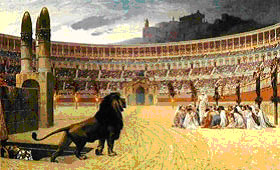
The Christian Martyrs' Last Prayer, by Jean-Léon Gérôme (1883).
However, this belief appears to have arisen only around the 16th century. Roman and early medieval accounts refer to Christians being martyred in various vaguely described locations in Rome (in the amphitheatre, in the arena etc) but without specifying which; there were, in fact, numerous stadia, amphitheatres and circuses in Rome. Archaeological excavations conducted in relatively recent times have brought to light in 1889 the Basilica Hilariana, erected by Manius Publicius Hilarus, and its unique mosaics of which it has been assumed that they contained inscriptions of superstition.It contains many artefacts from different eras and origins, which are now exposed ornamentation. Among these, the Egyptian obelisk of Ramsete II, popularly known as "spiedino" from the despoliation of the Temple of the Sun in Heliopolis; originally placed at the Shrine of Isis Capitolina (Temple of Isis), the Senate gave him in 1582 (but was installed in 1587) to Ciriaco Mattei after having long been behind the staircase dell'Ara Coeli from the fourteenth century; later (1817) was moved to the location. The obelisk is accompanied by a left legend: during the last work shift, there was an incident in which the base fell (for the breaking of rope) over a worker who lost limbs superiors that still lie under the same basement.
Many artefacts were transferred to the Vatican Museums. Some fountains were opera by Gian Lorenzo Bernini (called a dispatch from Jerome Mattei), but went destroyed.The portal monumental comes from the Villa Giustiniani-Massimo (or High-Lancellotti, or Villa Massimo the Lateran), once located on the Via Matteo Boiardo and today disappearance for edification, the portal was rebuilt here in 1931.The current is not the original main entrance, which was instead to the north, on the square SS.Giovanni and Paul. The street entrance leads to the "casino", or "Palazzetto Mattei", by Jacopo Del Duca, the current headquarters of the Italian Geographic Society.
Archaeological excavations conducted in relatively recent times have brought to light in 1889 the Basilica Hilariana, erected by Manius Publicius Hilarus, and its unique mosaics of which it has been assumed that they contained inscriptions of superstition.It contains many artefacts from different eras and origins, which are now exposed ornamentation. Among these, the Egyptian obelisk of Ramsete II, popularly known as "spiedino" from the despoliation of the Temple of the Sun in Heliopolis; originally placed at the Shrine of Isis Capitolina (Temple of Isis), the Senate gave him in 1582 (but was installed in 1587) to Ciriaco Mattei after having long been behind the staircase dell'Ara Coeli from the fourteenth century; later (1817) was moved to the location. The obelisk is accompanied by a left legend: during the last work shift, there was an incident in which the base fell (for the breaking of rope) over a worker who lost limbs superiors that still lie under the same basement.
Many artefacts were transferred to the Vatican Museums. Some fountains were opera by Gian Lorenzo Bernini (called a dispatch from Jerome Mattei), but went destroyed.The portal monumental comes from the Villa Giustiniani-Massimo (or High-Lancellotti, or Villa Massimo the Lateran), once located on the Via Matteo Boiardo and today disappearance for edification, the portal was rebuilt here in 1931.The current is not the original main entrance, which was instead to the north, on the square SS.Giovanni and Paul. The street entrance leads to the "casino", or "Palazzetto Mattei", by Jacopo Del Duca, the current headquarters of the Italian Geographic Society.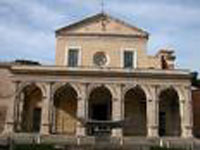 The church was built in ancient times, close to the barracks of the 5th cohort of Vigiles. The church was built no later than the 7th century. Pope Paschal I, who is to be credited for the age of renovation and artistic splendour that happened in Rome in early 9th century, rebuilt the church in 818-822, providing it with a noteworthy mosaic decoration.The attribute "in Domnica" has been differently explained. One interpretation is the derivation from dominicum, which means "of the Lord", and by extension "church". Another interpretation refers to the name of Cyriaca, a woman who lived close by, and whose name means "belonging to the Lord", Dominica in Latin. The attribute "alla Navicella" means "near the little ship", and refers to the Roman sculpture of a ship that has been placed in front of the church for a long time, turned into a fountain by Leo X.The Cardinal Deacon of the Titulus S. Mariae in Domnica is William Joseph Levada.Pope Leo X renovated the church in 1513-14, Andrea Sansovino directing the works and including the facade portico with tuscan columns. The internal columns are recycled from an ancient temple and crowned with Corinthian capitals. The ceiling is frescoed by Perin del Vaga, based on designs of Giulio Romano. The apse mosaid from the 8th century depicts Christ, angels, and apostles, Moses and Elias, Virgin and child on throne, and Pasquale I in ginocchio. There are also frescoes by Lazzaro Baldi
The church was built in ancient times, close to the barracks of the 5th cohort of Vigiles. The church was built no later than the 7th century. Pope Paschal I, who is to be credited for the age of renovation and artistic splendour that happened in Rome in early 9th century, rebuilt the church in 818-822, providing it with a noteworthy mosaic decoration.The attribute "in Domnica" has been differently explained. One interpretation is the derivation from dominicum, which means "of the Lord", and by extension "church". Another interpretation refers to the name of Cyriaca, a woman who lived close by, and whose name means "belonging to the Lord", Dominica in Latin. The attribute "alla Navicella" means "near the little ship", and refers to the Roman sculpture of a ship that has been placed in front of the church for a long time, turned into a fountain by Leo X.The Cardinal Deacon of the Titulus S. Mariae in Domnica is William Joseph Levada.Pope Leo X renovated the church in 1513-14, Andrea Sansovino directing the works and including the facade portico with tuscan columns. The internal columns are recycled from an ancient temple and crowned with Corinthian capitals. The ceiling is frescoed by Perin del Vaga, based on designs of Giulio Romano. The apse mosaid from the 8th century depicts Christ, angels, and apostles, Moses and Elias, Virgin and child on throne, and Pasquale I in ginocchio. There are also frescoes by Lazzaro Baldi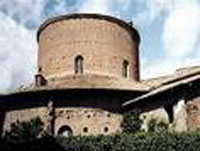 The edifice was consecrated by Pope Simplicius between 468 and 483. It was dedicated to protomartyr Saint Stephen, whose body had been discovered a few decades before in the Holy Land, and brought into Rome. The church was the first in Rome to have a circular plan, inspired by the Church of the Holy Sepulchre in Jerusalem.The walls of the church are decorated with numerous frescoes, including those of Niccolò Circignani (Niccolò Pomarancio) and Antonio Tempesta portraying 34 scenes of martyrdom, commissioned by Gregory XIII in the 16th century. All painting has an inscription explaing the scene and the name of the emperor who ordered the executions, as well as quotations from the Bible. The paintings are somewhat morbid, if not gruesome and naturalistic depictions of torture and execution.The altar was made by the Florentine artist Bernardo Rossellino in the 15th century. The painting in the apse shows Christ between two martyrs. The mosaic and marble decoration is from the period 523-530. One mosaic shows the martyrs St Primus and St Felicianus flanking a jewelled cross.The Chapel of Ss. Primo e Feliciano has very interesting and rare mosaics from the 7th century. The chapel was built by Pope Theodore I who brought here the relics of the martyrs and buried them (together with the remains of his father).
The edifice was consecrated by Pope Simplicius between 468 and 483. It was dedicated to protomartyr Saint Stephen, whose body had been discovered a few decades before in the Holy Land, and brought into Rome. The church was the first in Rome to have a circular plan, inspired by the Church of the Holy Sepulchre in Jerusalem.The walls of the church are decorated with numerous frescoes, including those of Niccolò Circignani (Niccolò Pomarancio) and Antonio Tempesta portraying 34 scenes of martyrdom, commissioned by Gregory XIII in the 16th century. All painting has an inscription explaing the scene and the name of the emperor who ordered the executions, as well as quotations from the Bible. The paintings are somewhat morbid, if not gruesome and naturalistic depictions of torture and execution.The altar was made by the Florentine artist Bernardo Rossellino in the 15th century. The painting in the apse shows Christ between two martyrs. The mosaic and marble decoration is from the period 523-530. One mosaic shows the martyrs St Primus and St Felicianus flanking a jewelled cross.The Chapel of Ss. Primo e Feliciano has very interesting and rare mosaics from the 7th century. The chapel was built by Pope Theodore I who brought here the relics of the martyrs and buried them (together with the remains of his father).

Santo Stefano Rotondo on a painting of Ettore Roesler Franz in the 19th century
Under the church there is a 2nd century mithraeum, related to the presence of the barracks of Roman soldiers in the neighbourhood. The cult of Mithras was especially popular among soldiers. The remains of Castra Peregrinorum, the baracks of the peregrini, officials detached for special service to the capital from the provincial armies, were found right under Santo Stefano Rotondo. The mihraeum belonged to Castra Peregrinorum but it was probably also attended by the soldiers of Cohors V Vigilum, whose barracks stood nearby on the other side of Via della Navicella.The mithraeum is currently being excavated. The remains of the Roman military barracks (from the Severan Age) and the mithraeum under the church remained closed from the public. A coloured marble bas-relief, "Mithras slaying the bull" from the 3rd century is today in Museo Nazionale Romano.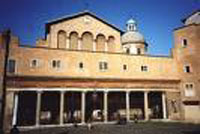 The church was built in 398, by will of senator Pammachius, over the home of two Roman soldiers, John and Paul, martyred under Julian in 362. The church received thus the Titulus Pammachii, and so it is recorded in the acts of the synod held by Pope Symmachus in 499.The inside has three naves, with pillars joined to the original columns. The altar is built over a bath, which holds the remains of the two martyrs.The apse is frescoed with Christ in Glory (1588) by Cristoforo Roncalli (one of the painters called il Pomarancio) [1588]; while below are three paintings: Martyrdom of Saint John, Martyrdom of Saint Paul, and the Conversion of Terenziano (1726) by Domenico Piastrini, Giacomo Triga, and Pietro Andrea Barbieri respectively. The sacristy features a canvas by Antoniazzo Romano of the Madonna & Child with Saints John the Evangelist & John the Baptist, and Saints Jerome & Paul. Below the nave, thus under the church, some ancient Roman rooms, dating back to the 1st-4th century, were found durin 19th century excavations.[1]
The church was built in 398, by will of senator Pammachius, over the home of two Roman soldiers, John and Paul, martyred under Julian in 362. The church received thus the Titulus Pammachii, and so it is recorded in the acts of the synod held by Pope Symmachus in 499.The inside has three naves, with pillars joined to the original columns. The altar is built over a bath, which holds the remains of the two martyrs.The apse is frescoed with Christ in Glory (1588) by Cristoforo Roncalli (one of the painters called il Pomarancio) [1588]; while below are three paintings: Martyrdom of Saint John, Martyrdom of Saint Paul, and the Conversion of Terenziano (1726) by Domenico Piastrini, Giacomo Triga, and Pietro Andrea Barbieri respectively. The sacristy features a canvas by Antoniazzo Romano of the Madonna & Child with Saints John the Evangelist & John the Baptist, and Saints Jerome & Paul. Below the nave, thus under the church, some ancient Roman rooms, dating back to the 1st-4th century, were found durin 19th century excavations.[1]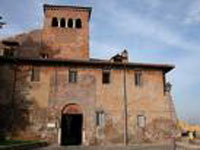 "Santi Quattro Coronati" means the Four Holy Crowned Ones [i.e. martyrs], and refers to the fact that the saints' names are not known, and therefore referred to with their number, and that they were martyrs, since the crown, together to the branches of palm, is an ancient symbol of martyrdom. According to the Passion of St. Sebastian, the four saints were soldiers who refused to sacrifice to Aesculapius, and therefore were killed by order of Emperor Diocletian (284-305). The bodies of the martyrs were buried in the cemetery of Santi Marcellino e Pietro, on the fourth mile of via Labicana, by Pope Miltiades and St Sebastian (whose skull is preserved in the church). Miltiades decided that the martyrs should be venerated with the names of Claudius, Nicostratus, Simpronianus and Castorius; these names - together to a fifth, Simplicius - were those of five Pannonian martyr stonemasons. These martyrs were later identified with the four martyrs from Albano, Secundus (or Severus), Severianus, Carpoforus (Carpophorus) and Victorinus (Vittorinus). The bodies of the martyrs are kept in four ancient sarcophagi in the crypt. According to a lapid dated 1123, the head of one of the four martyrs is buried in Santa Maria in Cosmedin.The apse containts the frescoes (1630) by Giovanni da San Giovanni of the four patron martyr saints, Severo, Severiano, Carpoforo e Vittorino. The altarpiece on the left nave of S.Sebastiano curato da Lucina e Irene was painted by Giovanni Baglione. The second courtyard holds the entrance to the Oratorio di San Silvestro, with frescoes of medieval origin, as well as others by Raffaellino da Reggio.
"Santi Quattro Coronati" means the Four Holy Crowned Ones [i.e. martyrs], and refers to the fact that the saints' names are not known, and therefore referred to with their number, and that they were martyrs, since the crown, together to the branches of palm, is an ancient symbol of martyrdom. According to the Passion of St. Sebastian, the four saints were soldiers who refused to sacrifice to Aesculapius, and therefore were killed by order of Emperor Diocletian (284-305). The bodies of the martyrs were buried in the cemetery of Santi Marcellino e Pietro, on the fourth mile of via Labicana, by Pope Miltiades and St Sebastian (whose skull is preserved in the church). Miltiades decided that the martyrs should be venerated with the names of Claudius, Nicostratus, Simpronianus and Castorius; these names - together to a fifth, Simplicius - were those of five Pannonian martyr stonemasons. These martyrs were later identified with the four martyrs from Albano, Secundus (or Severus), Severianus, Carpoforus (Carpophorus) and Victorinus (Vittorinus). The bodies of the martyrs are kept in four ancient sarcophagi in the crypt. According to a lapid dated 1123, the head of one of the four martyrs is buried in Santa Maria in Cosmedin.The apse containts the frescoes (1630) by Giovanni da San Giovanni of the four patron martyr saints, Severo, Severiano, Carpoforo e Vittorino. The altarpiece on the left nave of S.Sebastiano curato da Lucina e Irene was painted by Giovanni Baglione. The second courtyard holds the entrance to the Oratorio di San Silvestro, with frescoes of medieval origin, as well as others by Raffaellino da Reggio.fonti: www.wikipedia.org


1/14/2008

1/14/2008

1/14/2008

1/14/2008


1/14/2008